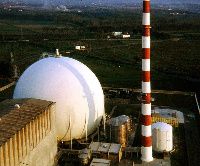From Guest Blogger Kelly Marsh: Earthquakes Can Damage Nuclear Power Plants
Throughout the history, earthquakes are known to cause high level of destructions and damages to our planet. Depending on the intensity of seismic waves, an earthquake can just shake our ground or literally cause ground rupture. The severity of damage is high in the case of ground rupture as it can dislocate large engineering structures like bridges, chemical plants, power plants, and very importantly nuclear power plants.
The entire world has seen the case of Fukushima Daiichi nuclear accident. Just like a ripple effect, the Tohoku earthquake triggered tsunami, which resulted in a series of equipment failures in the nuclear power plant, followed by nuclear meltdowns, and eventually released huge amount of harmful radioactive materials into the surroundings. The Fukushima nuclear accident has finally been registered as Level 7 on the International Nuclear Event Scale indicating huge impact on people and environment.
Even a year after that disaster, the risk of earthquakes shaking nuclear power plants are still high. Nuclear planners seem to access the risk based on the ability of a nuclear plant to withstand a shake, as massive and intensive earthquakes do not occur that often. But, how will we handle if rare earthquakes became even more intense and more frequent than the nuclear planners ever thought.
An earthquake of magnitude between 5 and 7 can easily pose a serious threat to any nuclear power plant in the world, and after watching the horrors of aftermath of the nuclear disaster in Japan, we need to rethink and reevaluate the safety regulations of all nuclear power plants in the world. Even a year after the Fukushima nuclear disaster, radiation experts are still finding high levels of radioactivity in puddles, drainage systems, parks and other areas in Fukushima city, needless, to mention about people eating radioactively contaminated food and inhaling radioactive particles.
As every reactor is build to withstand a certain magnitude, we think the risk comes into picture only in the case of sudden and massive earthquakes of high magnitude. But that may not be the only case and the threats just don’t end there.
Solar flares or solar emission is another threat that can trigger meltdown of fissionable material. In all nuclear power plants, the fissionable material is prevented from melting down by steady circulation of coolants pumped into the reactor using high-powered electric motors. This is one of the reasons why nuclear a power plant drive their power directly from electrical grids and does not rely on its own generated power.
In that case, even a small earthquake can destroy an electrical grid and thus stop power supply to the electric motor leading to meltdown of fissionable material. In the case of such continuous power outage, an onsite battery can provide backup power up to 10 hours and not more than that, as nuclear plants require very high amount of electricity to operate.
This really shakes our confidence in nuclear power. According to Nuclear Regulatory commission review, upgrades to a nuclear reactor would cost billions of dollars and years to implement. This may seem a justifiable reason, but if we can spend billions of dollars on other researches like Virtual reality, Robotics and Genetic engineering, then spending considerable amount of money to safeguard the public would be worth every penny. Imagine, if a pole shift occurs and triggers a megaquake, then nuclear power plants would just help to quicken the destruction of this planet.
About the author: Kelly is a blogger by profession. She loves writing on technology and luxury. Beside this she is fond of blogging. Recently an article on perrier jouet attracted her attention. These days she is busy in writing an article on garden design ideas.


Poor nations will insist on doing anything necessary to lift themselves out of poverty. Without nuclear plants, that will mean increasing their use of fossil fuels so much that it won’t matter whether we here in the U.S. totally stop using fossil fuels. Global warming will then be certain to cause more problems than a few nuclear accidents ever could.
It is imperative that we improve nuclear technology to make it safer and more economical. It is also clear that passive emergency cooling is essential for safety.
Yes, earthquakes can damage reactors, along with buildings, roads and a lot of infrastructure. Let’s bear in mind tho’ that the earthquake didn’t damage any reactors in Japan. The tsunami did. Those reactors which were not hit by the 15m (45′) wave were not damaged. This is pretty amazing considering the age and their design criteria.
This does not excuse in any way the mind-numbingly short-sighted design flaws in the safety backup systems. Very few complex systems of any type are still viable after 40 or 50 years. How’s that Corvair or Pinto working for you? Clearly safety re-think and retrofits should be applied to all reactors of that vintage, whether near the sea or not.
Better yet, IMHO, where feasible the old plants should be shut down as soon as safe new nukes can be installed to burn that ‘waste fuel’.